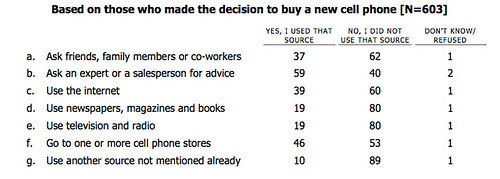Bruce Temkin of Forrester points out that customers want face to face interaction. 45% prefer to speak to an agent over the phone, than other ways such as FAQ, self service, etc. In our book, the question thus becomes how can you enable the "best way" for your customers to contact you? Publishing a click-to-call button is surely a good "invitation to conversation", but so is just giving the customer a call when you know they are likely to want help. How many calls do you usually get because part A does not in fact slide easily into part B? There are different points in the customer interaction process where they will want to speak with someone, make it easy, and make it a great experience.
A related question is how to link all lead generation activity from "leaflet drops" to "adsense" back to actual purchase activity, and measures of customer loyalty is a current holy grail of many companies. Right now what we have is the fallacy of the "last click" (i.e. the last place we clicked in from is the reason we are at amazon, dell.com, etc.). It's not. A friend might have recommended that we check out a review site, a comment there might have brought us to a blogger, who recommended that we check out his story on zdnet.com, after which we clicked through to that computer etc. YET, (play drum roll here) Pew Internet Study found that over 20% of Americans have never even used email.
Something is broken here.
Lets Look A Bit More At This Pew Report
For those who have bought music in the prior year:
- 83% say they find out about music from the radio, the television, or in a movie.
- 64% say they find out about music from friends, family members, or co-workers.
- 56% say they find out about music through various online tools, such as going to a band’s or artist’s website or streaming samples of songs to their computers.
Among those who have purchased a cell phone in the prior year:
- 59% asked an expert or salesperson for advice.
- 46% go to one or more cell phone stores.
- 39% use the Internet.
The “bottom line” conclusion is the following: “Even though many buyers use the Internet in product research, relatively few say online information had a major impact on the product choice they eventually made. Only 7% of music buyers, 10% of cell phone buyers, and 11% of those who bought or rented a home in the prior year say that online information had a major impact on their decision.”
So, yes the Internet is a really important research and comparison tool, FOR SOME DEMOGRAPHICS, but not for all. Many will look to the lead user/gatekeeper in their social circle, and there are indeed many interpolating influences at work here. The question I would pose for you and your company, is do you have a real roadmap and activity sheet to build out a clearer understanding of how your customers make decisions?
I'm guessing not, so something is broken here.
I can't leave this subject without also highly, highly recommending that you read this post from Greg Sterling, at Screenwerk. I too have been following NearByNow for quite a while, and the "killer app" behind their service (which I would have strong recommendations to change) is that the current "dark data" of unsearchable inventory in a retail shopping center is exposed, and becomes searchable. This is a mapping and melding of the physical and the digital in a way that enriches both. These kinds of services have the potential to radically change the nature and flow of the buying process.
Now Why Don't Credit Cards Do This?
The ever excellent Nudge blog points out that your credit card limit should not be a "de facto" blunt instrument. Why can't we set our limits for specific purchases, god knows, I need something to double check with me if I really want to buy those books :) Set your own credit limit for each category of purchase. Now that's some neat thinking. Why not have a little routine that you have to go through in order to validate what might be a impulse buy (i.e. if I buy anything over $100 please read out my credit card balance before authorizing my purchase!). What I love about this idea, is that people could customise and mashup what, right now, seems a pretty lame process.
So, Services Can Be Mashed Up For Personalisation? Duh.
If you are wondering about "Google Think", look at all the cool things you can do with gMail. Why am I such a big fan? Because Google Mail "atomizes" and "API's" everything, and that opens up the opportunity for innovation. Its "customer driven mashup" by any other name. Take the NearByNow example above, why could you not ask for "show me every store that sells Levi jeans for men" and have it on a "live map" (i.e. as the special offer jeans sell out, the count goes down in real time etc. etc.).
To follow the theme Dion Hinchcliffe is developing some excellent diagrams to help people understand what this landscape looks like at this point in time.
PersonalInfoCloud blog also has some interesting thoughts on how to visualise this landscape. A link to that diagram is here.
My take away, is that the people familiar with technology, our 2.0 crowd, will see, use and abandon services with great regularity. Some will stick. Those that show real capability of getting scale will be bought by those that can distribute, i.e. the big installed players.
In a final note, I was sad to hear that KnowNow are to cease trading. It was a great idea. I think it just needed a "bigger home".






No comments:
Post a Comment